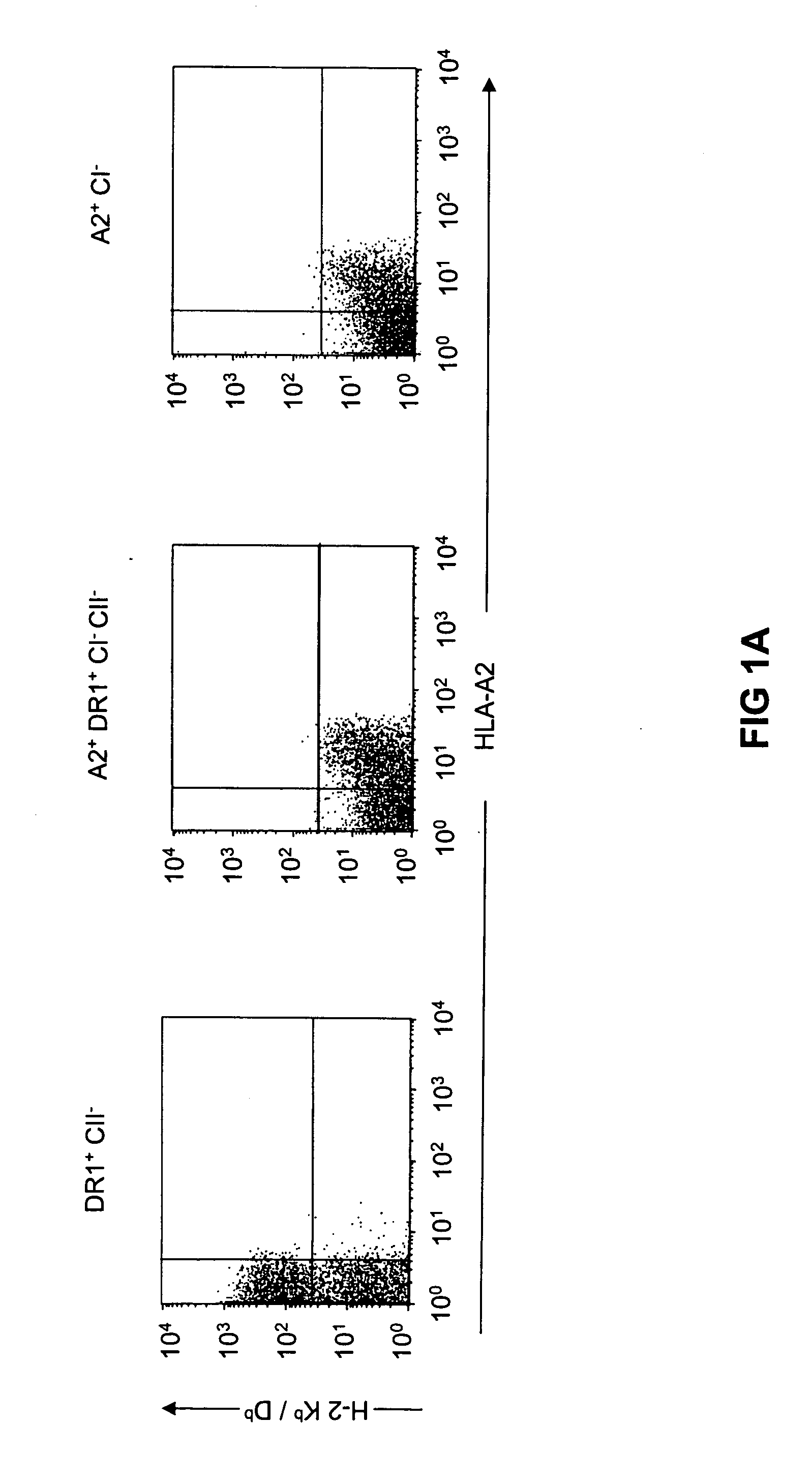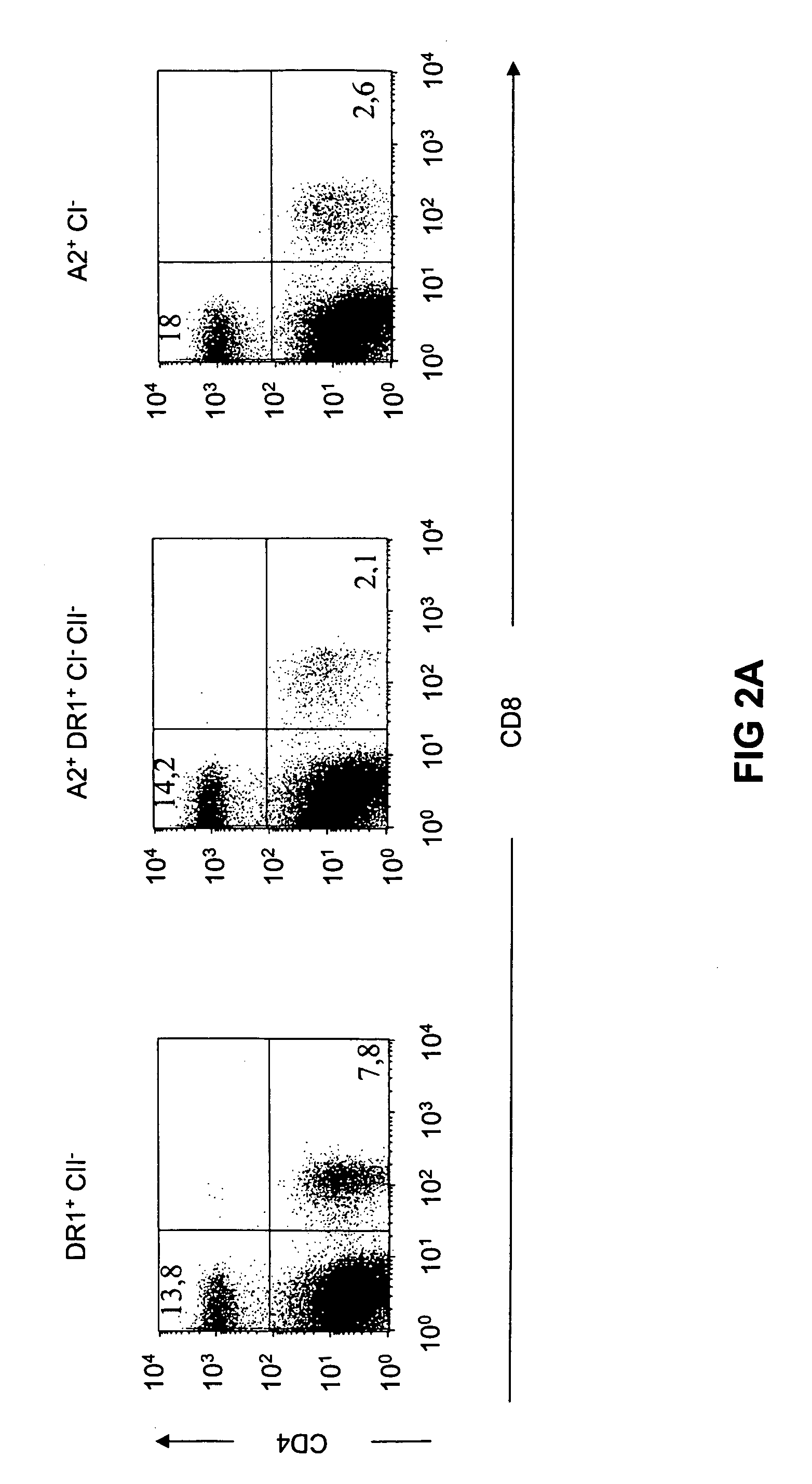Transgenic mice having a human major histocompatibility complex (MHC) phenotype, experimental uses and applications
a histocompatibility complex and transgenic mouse technology, applied in the field of transgenic mice having a human major histocompatibility complex (mhc) phenotype, experimental use and application, can solve the problems of insufficient understanding of the requirements for in vivo priming of ctl, and hla class i and ii human responses cannot be assessed in the same mous
- Summary
- Abstract
- Description
- Claims
- Application Information
AI Technical Summary
Benefits of technology
Problems solved by technology
Method used
Image
Examples
example 1
Cell Surface Expression of MHC Molecules
[0123] Cell surface expression of the HLA-A2.1, H-2 Kb / Db, HLA-DR1, and H-2 IAb molecules was evaluated on splenocytes by flow cytometry. As illustrated in FIG. 1a, a similar level of HLA-A2.1 expression was observed in HLA-A2.1- / HLA-DR1-transgenic, H-2 class I- / class II-KO mice and HLA-A2.1-transgenic, H-2 class I-KO mice, while HLA-A2.1 was absent and H-2 Kb / Db expressed exclusively in HLA-DR1-transgenic, H-2 class II-KO mice. Cell surface expression of HLA-DR1 and H-2 IAb was measured on B220+-enriched B cells. As shown in FIG. 1b, a similar level of HLA-DR1 expression was observed in HLA-A2.1- / HLA-DR1-transgenic, H-2 class I- / class II-KO mice and HLA-DR1-transgenic, H-2 class II-KO mice, whereas no expression was detected in HLA-A2.1-transgenic, H-2 class I-KO mice. Cell surface expression of the transgenic molecules (especially HLA-DR1) was, however, lower than the expression of endogenous H-2 class I and class II molecules.
example 2
Peripheral CD4+ and CD8+ T Cells
[0124] CD4+ and CD8+ splenic T cell numbers were determined by immunostaining and flow cytometry analysis as illustrated in FIG. 2a.
[0125] CD4+ T cells represented 13-14% of the splenocyte population in both HLA-A2.1- / HLA-DR1-transgenic, H-2 class I- / class II-KO mice and HLA-DR1-transgenic, H-2 class II-KO mice. In contrast, only 2-3% of the cells were CD4+ in H-2 class II-KO mice (data not shown), in agreement with the initial report on mice lacking MHC class II molecules (Cosgrove, D. et al., Cell 66, 1051-1066 (1991)). As expected, expression of transgenic HLA-A2.1 molecules led to an increase in the size of the peripheral CD8+ T cell population, which reached 2-3% of the total splenocytes in both HLA-A2.1- / HLA-DR1-transgenic, H-2 class I- / class II-KO mice and HLA-A2.1-transgenic, H-2 class I-KO mice, compared to 0.6-1% in the β2 microglobulin (β2m)-KO MHC class I-deficient mice (Pascolo, S. et al., J Exp Med 185, 2043-2051 (1997)).
[0126] The re...
example 3
TCR BV Segment Usage
[0130] As the presence of a single MHC class I and single MHC class II molecule could diminish the size and diversity of the TCR repertoire, the expression of the various BV families and the CDR3 length diversity was studied as previously described (Cochet, M. et al., Eur J Immunol 22, 2639-2647 (1992)) by the RT-PCR-based immunoscope technique, on purified splenic CD4+ or CD8+ T cells. Peaks of significant magnitude with a Gaussian-like distribution were observed for most BV families (15 out of the 20 analyzed) in both CD8+ (FIG. 2b) and CD4+ (FIG. 2c) populations of T cells. Such profiles observed on peripheral T lymphocytes are typical of functionally rearranged BV segments with a 3 nucleotide length variation of the CDR3 subregions from one peak to the next (Cochet, M. et al., Eur J Immunol 22, 2639-2647 (1992)).
[0131] Absence of expansion (or profoundly altered profile) as observed for BV 5.3 and 17 were expected since these two BV segments are pseudogenes...
PUM
| Property | Measurement | Unit |
|---|---|---|
| Ratio | aaaaa | aaaaa |
| Cytotoxicity | aaaaa | aaaaa |
Abstract
Description
Claims
Application Information
 Login to View More
Login to View More - R&D
- Intellectual Property
- Life Sciences
- Materials
- Tech Scout
- Unparalleled Data Quality
- Higher Quality Content
- 60% Fewer Hallucinations
Browse by: Latest US Patents, China's latest patents, Technical Efficacy Thesaurus, Application Domain, Technology Topic, Popular Technical Reports.
© 2025 PatSnap. All rights reserved.Legal|Privacy policy|Modern Slavery Act Transparency Statement|Sitemap|About US| Contact US: help@patsnap.com



